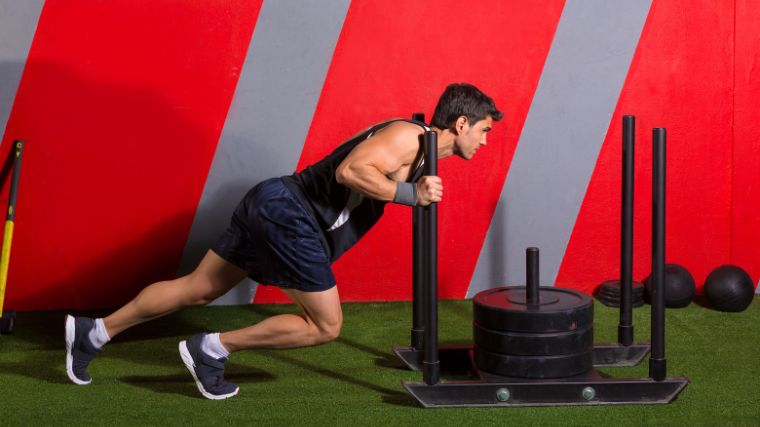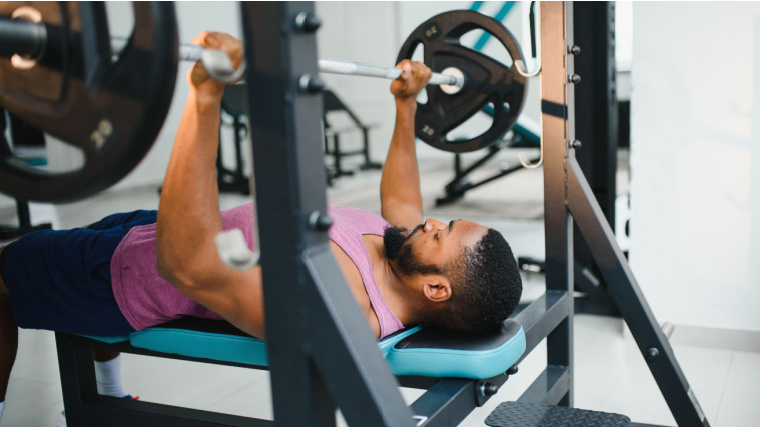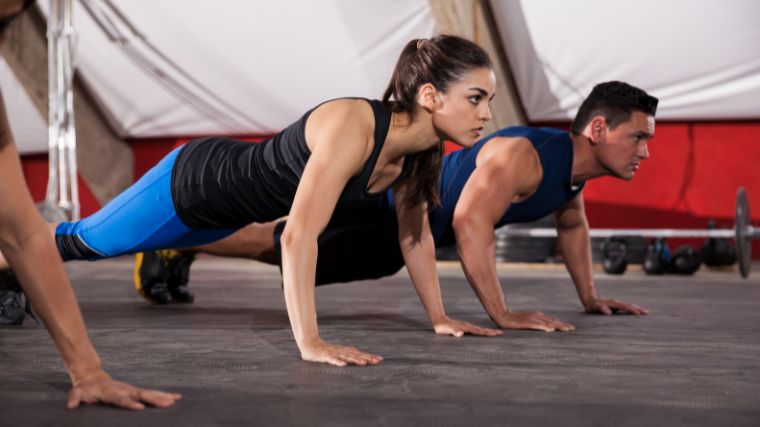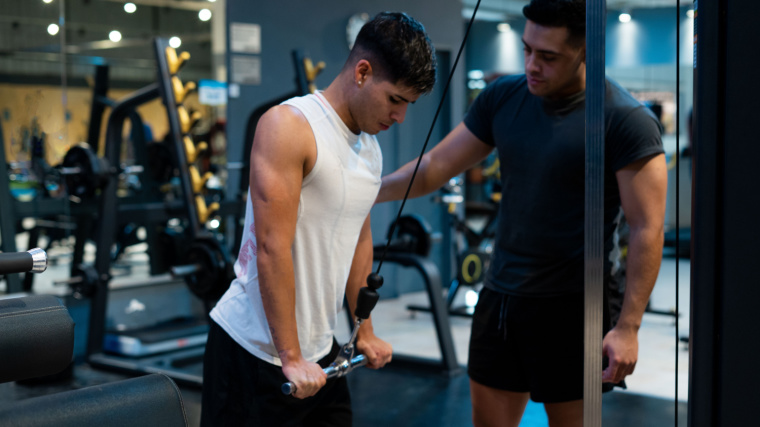If you follow fitness, it probably feels like the posterior chain is all the rage. (For the uninitiated, your posterior chain is basically your backside. It counts all of the muscles that span the base of your skull down to your heels.)
And, for many reasons, the hype is justified; your back muscles are integral for good posture and high-octane athletic performance. However, a healthy body is a balanced body, which means giving your other muscles the credit they’re due.

Generally speaking, the muscles on the anterior, or front, of your body are considered “pushing” muscles. Think of your chest and shoulders here. But all pushing exercises aren’t created equal, and some stand to give you much more bang for your buck than others. Here are some of the best push movements you can do to push yourself to new heights in the weight room.
8 Best Push Exercises
- Barbell Bench Press
- Overhead Press
- Push-Up
- Sled Push
- Medicine Ball Chest Press
- Medicine Ball Lateral Throw
- Dip
- Triceps Pressdown
What Are Push Exercises?
Before you dive into any push exercise, you should familiarize yourself with a bit of biomechanics. Understanding what pushing movements are — and, especially, what they aren’t — will help you perform better in the gym, ultimately getting you to the results you’re after that much quicker.
Anatomically, there’s no such thing as a “pushing” muscle. Your skeletal muscles all contract in the same way, by pulling their individual fibers closer together to move your bones. These fibers, called myofibrils, constrict and twist around each other to shorten the muscle and pull on a joint.

[Read More: 5 At-Home Workouts for Strength, Muscle Growth, Power, and More]
Even though there may not be a specific pushing muscle or muscle group, pushing is a fundamental aspect of human movement. Regarding exercise, pushing movements generally refer to exerting effort to move resistance away from your body, or to move your body away from a fixed point.
The musculature that performs these actions are commonly referred to as your “pushing muscles.” Your pectoralis, deltoids, and triceps are your primary upper body pushing muscles.
1. Barbell Bench Press
The standard bench press is perhaps the most fundamental upper-body push exercise most people perform in the gym. Benching with a barbell even counts as an entire third of the sport of powerlifting. When constructing a push-centric workout, some form of bench press is basically mandatory.
One of the best parts of the bench press motion is its versatility; you can bench with a variety of different equipment such as dumbbells or kettlebells, but the barbell is considered the standard. Benching is great for developing chest and triceps strength, and has a fairly straightforward technique.
How To Do It
- Lie down on the bench press station with your feet planted on the floor and your eyes directly underneath the barbell.
- Grab the bar with a double-overhand, roughly shoulder-width grip, then unrack it by pulling it straight out of the rack until it settles directly above your shoulders.
- Brace your core, inhale, and press your feet into the floor, then initiate the move by bending at the elbows and lowering the bar down,
- Lower the bar down and forward slightly until it touches roughly around your sternum, keeping your behind in contact with the bench the entire time.
- Once the bar drops as much as is comfortable, reverse the motion and press it up and back until it comes motionless above your shoulders with straight arms.
Coach’s Tip: Pinch your shoulder blades together before you unrack the barbell and keep them retracted as you bench to improve your stability and strength.
Sets and Reps: Try out 3 or 4 sets of 5 to 8 repetitions.
2. Overhead Press
Overhead pressing is a fundamental skill both in and out of the gym. Your pushing muscles, particularly your shoulders, are capable of bearing tremendous weights and stabilizing heavy loads above your head. Pressing in the gym develops these qualities in spades.
[Read More: The Best Online Workout Programs For Coaching, Cardio, Value, And More]
The dumbbell overhead press provides all the benefits of unilateral training while strengthening your anterior deltoids, triceps, and upper back muscles in the process.
How To Do It
- Grab a pair of dumbbells and sit down in a low seat with some form of back support and the weights resting on top of your knees.
- “Kick” the dumbbells up to your shoulders with your legs. In the starting position, your upper arms should be parallel to the floor with a 90-degree bend in your elbows.
- Begin the press by pushing the weights up and inward until your elbows straighten fully and your arms are both perpendicular to the floor.
Coach’s Tip: At the end of the overhead press, your upper arms should be aligned with your ears and your elbows fully extended.
Sets and Reps: Do 3 to 4 sets of 8 to 12 repetitions.
3. Push-Up
The humble push-up is one of the first exercises most people do, usually long before they ever undertake a beginner workout routine. The push-up is a gym class staple for a reason — it’s a fantastic introductory push exercise, but the benefits don’t end there.
Push-ups are accessible and you can perform them basically anywhere without needing to rely on any equipment at all (though a yoga mat might make things more comfortable). They also teach you how to develop midline stability while engaging your chest, shoulders, and arms.
How To Do It
- Assume a plank position on the floor with your arms straight. Establish rigidity from head to toe, keeping your hips and knees firmly extended. Then, inhale.
- Lower your body down slowly to the floor by breaking at the elbows and dropping as far as you’re able, or until your shirt gently touches the floor.
- Press yourself back up to the starting position by straightening your arms.
Coach’s Tip: Focus hard on keeping your trunk and legs in line with one another, without your knees bending or your pelvis sagging.
Sets and Reps: Start with 3 sets of 10 repetitions and build on your rep count until you can do 3 sets of 20.
[Read More: How to Do 100 Push-Ups a Day]
4. Sled Push
You don’t have to live in the squat rack or hang out by the dumbbells to train your pushing muscles. In fact, you can build on your cardiovascular capacity with some body conditioning and become a better “pusher” at the same time.
[Read More: The Best Back Workout for Men, Women, Strength, and More]
The aptly-named sled push, if you have access to it, is a great way to get your heart rate up and train your shoulders and arms isometrically as well.
How To Do It
- Find a stretch of clear space across which to push your sled.
- Get behind the sled and load it up with weight if you’d like to.
- Take a staggered stance and grab ahold of the handles with straight arms.
- Lean forward until your torso is at roughly a 45-degree angle.
- Push off the ground with your back foot to start moving the sled and continue to drive forward with each leg.
Coach’s Tip: The lower you can get with your torso, such that your arms and trunk form a straight line, the better your leverage will be.
Sets and Reps: For the sled push, try 3 to 5 rounds of at least ten paces per leg depending on how much weight you’ve loaded up.
5. Medicine Ball Chest Press
If you’re interested in increasing strength and training power, you should be willing to look beyond the barbell from time to time. The medicine ball chest press is a severely underrated push exercise that enhances both qualities simultaneously.
[Read More: Use the Bent-Over Row to Make Big Gains With Big Weights]
Benefits of the medicine ball chest press include it being a wonderful warm-up exercise, it applies low stress to your joints, and it closely mimics the muscle recruitment patterns of moves like the close-grip bench press or push-up.
How To Do It
- Grab a light-to-medium medicine ball and palm the sides with your hands. Hold it at chest level and take an athletic stance a few feet from a wall.
- In one swift motion, push the medicine ball away from you with your arms, driving it forward into the wall in front of you.
- Allow the ball to hit the wall and fall to the floor. Pick it up, recover, and go again.
Coach’s Tip: This movement is meant to be explosive. Drive the ball away from you as forcefully as you can.
Sets and Reps: Bang out 2 to 3 rounds of 5 repetitions in quick succession.
6. Medicine Ball Lateral Throw
Almost all pushing movements involve moving an object away from the body, but don’t get stuck thinking that means you have to literally push in the same direction every time. Working in other planes of motion can fill out gaps in your fitness regime, helping you build resilience in areas you may have overlooked.
You can use an exercise like the medicine ball lateral throw to accomplish just that. This move will engage many of your upper-body pushing muscles while also training your core. Lateral throws also improve general athleticism and anti-rotary stability.
How To Do It
- Stand holding a medicine ball at chest with an athletic, shoulder-width stance perpendicular to a nearby wall.
- In one swift motion, twist your far shoulder toward the wall and chuck the ball sideways as forcefully as you can.
- Recover the ball, swap sides, and repeat.
Coach’s Tip: Focus on pushing your “far” arm across your midline to hurl the medicine ball sideways.
Sets and Reps: Try 2 or 3 rounds of 5 throws per side.
7. Dip
The classic dip is both a calisthenics staple movement and an old-school bodybuilding favorite for developing muscularity and strength in the pecs, shoulders, and arms. You can use dips as the centerpiece of a push workout by adding weight, or incorporate them into your warm-up or as part of a finisher.
[Read More: Get Freakishly Strong With the 5×5 Workout Program]
No matter what, dips remain a stellar option when shopping for reliable push movements. They’re also easy to scale up or down to your level of fitness, usually by adjusting how you set up for the movement and whether or not you choose to add additional weight beyond that of your own body.
How To Do It
- Suspend yourself from a pair of parallel dip bars with your elbows firmly locked and your shoulders depressed away from your ears.
- Bend your knees and lock your ankles if needed. Inhale and brace your core.
- From here, break at the elbows and lower your body down until your upper arm comes perpendicular with your forearm.
- Reverse the motion and press back up with your chest, shoulder, and triceps until your arms lock out once again.
Coach’s Tip: Keep your shoulders packed down and away from your ears at all times during the dip.
Sets and Reps: Perform several sets of dips to near failure until you can do 20 reps at a time, then consider adding weight.
8. Triceps Pressdown
Your triceps ride shotgun during every upper-body pushing exercise you perform, since they retain the crucial duty of extending your arm as you press. As such, any good push routine should contain at least one movement devoted specifically to strengthening your triceps.
The cable triceps pressdown is a fantastic pick, especially if many of your other pushing movements involve free weights like barbells or dumbbells. The cable provides smooth and consistent mechanical tension to your muscles and makes it easy to isolate your triceps so you can take them to the brink (and beyond).
How To Do It
- Stand facing a cable tree with the fixture adjusted to about eye level. Attach your handle of choice, whether it be the V-bar, straight bar, or a rope.
- Pull the attachment away from the cable to apply tension. Tuck your upper arms firmly against your sides and allow your elbows to bend with your forearms pointing upward.
- From here and without moving any other part of your body, use your triceps to extend your arms, driving the handles downward toward your legs.
Coach’s Tip: Take the time to fiddle with various grip attachments until you land on something comfortable that allows you to really feel your triceps working.
Sets and Reps: 3 to 4 sets of 8 to 12 repetitions should do the trick.
Push Workout Warm-Up
To warm up for a push-focused workout, follow the same principles as any other muscle group: Start general and then get specific. Your goals should be to increase your core temperature, adjust your mindset in anticipation of strenuous activity, and then warm or activate any relevant joints.
Many pushing movements demand a lot of your shoulder stability and scapular control, particularly if you’re doing a powerlifting or bodybuilding workout containing lots of heavy lifting. In such cases, you should include at least one upper back exercise as a primer as well.
[Read More: The Best Full-Body Bodybuilding Workout for Beginner to Advanced Lifters]
Here’s a good all-around warm-up protocol for any workout containing more than one intense push movement:
- 5 to 10 minutes of low-intensity cardiovascular exercise.
- 1 to 3 sets of an upper back or shoulder drill such as bar hangs, resistance band pull-aparts, face pulls, or rear delt flyes.
- 1 to 4 warm-up sets of your first compound pushing movement, beginning with just your body weight or a very light load to practice your technique.
Benefits of Push Exercises
Put simply, pushing exercises have a lot going for them. In fact, you can build a whole workout around a handful of pushing movements if you wanted to. They’re easy to learn, neatly carry over to real-world scenarios, and are powerfully effective at building muscle.
Easy To Learn
Some of the fundamental movement patterns of exercise are easier to learn than others. Most pushing movements fall in the middle, and are much easier to pick up than moves like squats, deadlifts, or gymnastics exercises.
You’ll generally find most push exercises come naturally since you likely have performed similar motions in your day-to-day life, such as pushing a lawnmower, shuffling through a crowd, or participating in a contact sport. As such, you should acclimate to the demands of a push-focused workout pretty quickly.
Convenient and Accessible
The relatively straightforward technique coupled with ease of access make pushing movements nearly unparalleled in terms of convenience. While accessibility certainly does vary from exercise to exercise, most commercial gyms come outfitted with more than enough equipment to perform nearly any pushing movement.

Further, most forms of calisthenics exercises are considered push exercises, as bodyweight training typically involves pushing against the downward force of gravity.
Movement Synergy
Pulling and lower-body movements are often intricate, involving many different joints and disparate muscle groups. By contrast, many pushing exercises contain plenty of biomechanical overlap.
The strength and stability skills you develop from one pushing movement, such as a barbell bench press, should transfer nicely into similar exercises like a standing overhead press, since the muscles and joints involved experience roughly similar stimuli.
Real-World Functionality
Most people utilize their “push” muscles far more often in their day-to-day lives than the musculature in their posterior chain or lower bodies. If you exercise for the purpose of improving your quality of life, you’ll find that strengthening muscles like your shoulders and triceps translates nicely to quicker and more efficient performance of daily chores and tasks.
Great for Muscle Growth
The relative simplicity and heavy carryover between pushing exercises make them great for muscle growth. Push movements are also easy to load up with plenty of weight to induce progressive overload and increase strength.

[Read More: What Are Workout Splits and Which Is the Best One?]
For most people, two or three push movements performed back-to-back during a workout is more than enough to adequately fatigue the requisite muscles and induce some hypertrophy. When it comes to pushing movements, you can get a lot out of a little!
What Are the Pushing Muscles?
Anatomically speaking, you don’t necessarily have a specific “push muscle.” Pushing is a biomechanical action, not an anatomical duty. The following muscles and muscle groups are typically engaged when you perform any push exercise, depending on the equipment you use or the technique you employ:
- Pectoralis Major & Minor: Your pectoral muscles connect from your ribcage onto your upper arm and shoulder blade. They mainly function to draw your arm forward in space, or inward toward your midline.
- Anterior & Lateral Deltoid: The side and front heads of your deltoid muscle connect from your scapula to your collarbone and upper arm. Your delts generally assist larger muscles like the pecs in arm flexion and adduction.
- Triceps Brachii: Any upper-body pushing movement you perform will generally involve straightening your elbow, which is the specific role of your triceps. Your triceps fall on the backside of your upper arm, but are an essential pushing muscle nonetheless.
You can certainly make a case that some muscles in your lower half perform pushing exercises as well, such as the quadriceps and calves. Generally speaking, pushing muscles antagonize, or perform the opposite role of, the musculature found on the back half of your body.
More Training Content
- What the Heck Is a Tempo Run?
- Try These Elliptical Workouts for Weight Loss
- The Best Landmine Shoulder Exercises You Can Do
Featured Image: lunamarina / Shutterstock